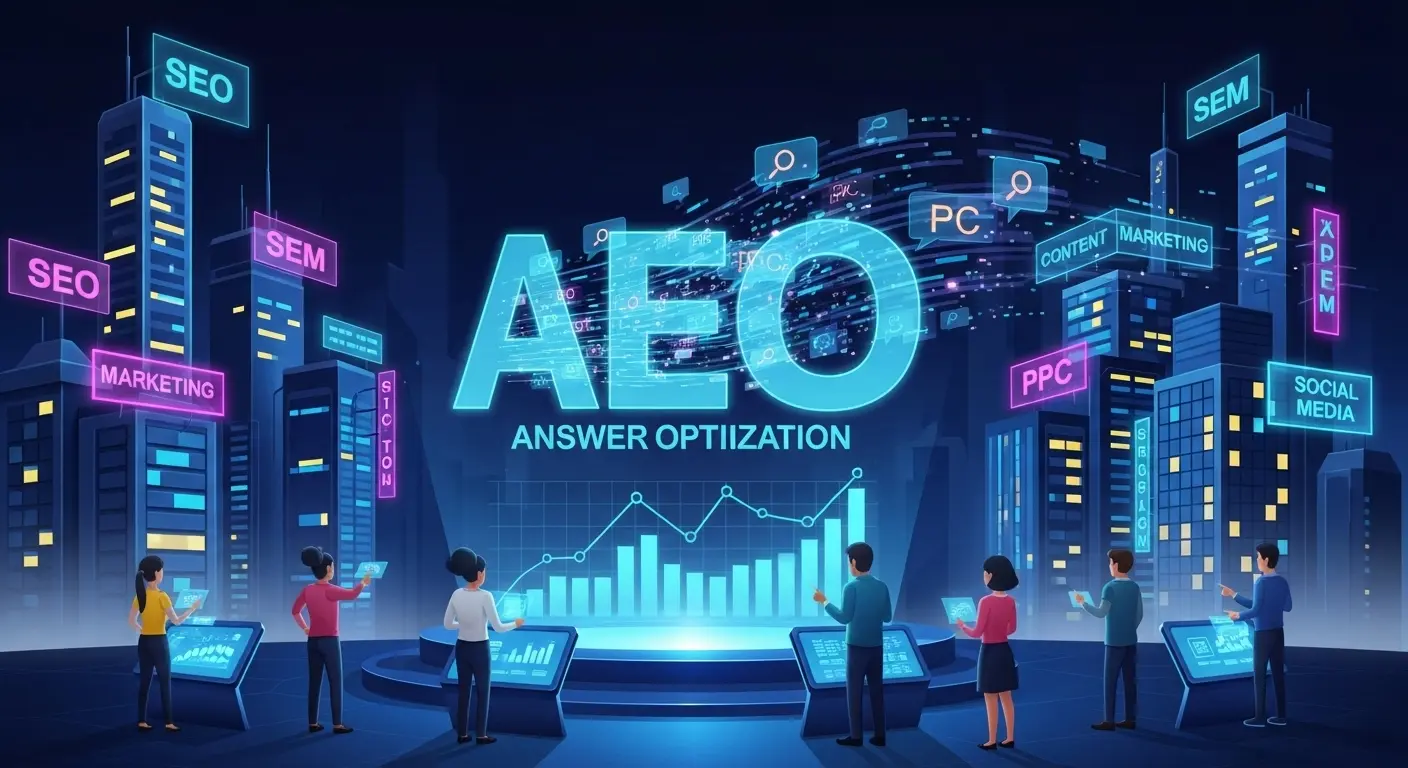Did you know that out of every 1,000 Google searches, only about 360 actually lead to a website click? That means more than half the time, people are getting the information they need without ever leaving the search results.
When you ask your voice assistant, “What’s the best mortgage rate right now?” it gives you a quick, direct answer instead of pulling up ten different links. The same thing happens when you type a question into Google and see that small box at the top with the exact answer.
This shift highlights something important. People don’t just want websites anymore, they want clear answers. That is where AEO, or Answer Engine Optimization, comes in. It’s the next step in digital marketing, focusing not only on ranking your page but also on making sure your content becomes the trusted answer for users and platforms.
In this guide, we’ll learn what AEO is, how it works, why it matters for businesses today, and how it compares to traditional SEO.
What Exactly is AEO?
At its core, AEO is about creating content that directly answers people’s questions. Instead of only trying to appear high in search results, the goal is to become the exact answer that platforms like Google, Siri, or Alexa choose when someone asks a question.
Think of it like this: if SEO is about making your store easy to find on a busy street, AEO is about placing your best product right into the customer’s hands the moment they ask for it.
The Technology Behind AEO
The rise of AEO is powered by tools people use daily. Chatbots and virtual assistants such as Siri, Alexa, and Google Assistant are designed to give fast, spoken answers. Google now offers “AI Overviews” that summarize results for users. Platforms like Perplexity also provide ready-made answers without sending people to another site. On top of that, there are featured snippets and knowledge panels, the boxes you see at the top of search results with instant answers. All of these rely on one thing: content that is structured to provide clear, direct information.
Key Characteristics of AEO
To perform well with AEO, your content needs three main qualities:
- Conversational: Written the way people naturally ask questions.
- Concise: Short, direct answers should come first, with extra detail added afterward.
- Intent-focused: Instead of stuffing in keywords, the focus is on what the person really wants to know.
In short, AEO is about shifting the mindset from “How do I rank this page?” to “How do I become the trusted answer?”
Why AEO Matters for Modern Businesses
Search behavior has changed dramatically. A few years ago, people typed short keywords into Google, clicked through to a handful of websites, and compared answers themselves. Today, that pattern is shifting quickly. Voice assistants are driving much of this change, with usage projected to reach 8.4 billion devices worldwide by 2024. That figure is staggering, since it exceeds the total global population. The takeaway is simple: people are asking questions out loud and expect their devices to respond with instant, reliable answers.
It isn’t just about voice search. Google’s AI Overviews now handle more than half of all queries without requiring a single click. Instead of scrolling through ten blue links, users see a ready-made summary drawn from multiple sources. This has led to what are called “zero-click searches,” where people find the information they need before ever visiting a website. For businesses that depend on search traffic, this is a wake-up call. If your brand is not featured in these instant answers, you risk being invisible to a large share of your audience.
The opportunity, however, is significant. Brands that appear in AI-generated responses report a 29% increase in trust scores. Customers naturally assume that if a trusted platform highlights your business, it must be credible. Visibility also climbs sharply. Research shows brands using AEO see three times more visibility in AI answers compared to those relying only on SEO. Being positioned as the chosen expert whenever a customer asks a question in your niche translates not just into traffic but into lasting authority.
Timing is crucial. Much like SEO in its early years, the businesses that begin optimizing for answers now will be the ones to dominate later, once competition becomes fierce. Many industries are still learning how to apply AEO, leaving space for proactive companies to establish themselves as leaders.
The outlook for growth is undeniable. Gartner predicts that by 2026, one quarter of all organic traffic will come directly from AI chatbots and virtual assistants. That means one in four potential customers will be finding answers through automated platforms rather than clicking into a website. On top of this, interest in AEO has surged sharply since January 2025, with more companies investing in dedicated tools and strategies.
For modern businesses, the question is no longer whether AEO will matter but whether they will adapt in time to benefit. Those who take action now can shape the conversation, build trust earlier, and secure a competitive advantage before the rest of the market catches up.
Key Differences between AEO & Traditional SEO
When you hear about AEO, it’s easy to assume it is replacing SEO altogether, but that is not the case. Both serve different purposes, and understanding how they work together is the key to staying competitive.
| Aspect | Traditional SEO | Answer Engine Optimization (AEO) |
| Primary Goal | Rank high on search engine results pages (SERPs) | Become the direct, trusted answer source |
| Content Strategy | Keyword-rich, in-depth articles | Concise, structured, answer-focused content |
| User Query Style | Short, keyword-based searches | Conversational, natural language questions |
| Success Metrics | Rankings, clicks, organic traffic | Featured snippets, voice results, AI citations |
| Content Format | Long-form blogs, guides, evergreen pages | FAQs, lists, tables, step-by-step guides |
| Optimization Focus | Keywords, backlinks, technical setup | Intent, schema markup, structured answers |
Put simply, SEO helps users find your website, while AEO helps them find your answer. Both are valuable, but they serve different stages of the customer journey.
For example, someone searching “best project management software” on Google might click through multiple sites if you havFe optimized well with SEO. But if they ask their voice assistant, “What’s the best project management software for small teams?” they will likely hear just one or two answers. If your content is optimized for AEO, your brand could be the one read out loud.
This does not mean you should abandon SEO. Far from it. Strong SEO ensures your site is still discoverable, builds authority, and drives traffic where people want to explore further. AEO, on the other hand, places you in front of customers at the exact moment they ask a question, often before they even know which website they might visit. The smartest approach is to balance both, using SEO to capture traditional clicks and AEO to secure visibility in answer-driven platforms.
Conclusion
The way people search is evolving. With voice assistants, AI overviews, and zero-click searches becoming more common, showing up as the trusted answer is now just as important as ranking in search results. This is where AEO makes a real difference.
Businesses that embrace AEO early will gain a significant competitive advantage. They will be the ones customers hear about first, trust more, and rely on when making decisions. Those who delay risk being left behind as search engines and AI platforms continue shifting toward direct answers.
The best thing is you do not need to overhaul everything at once. You can begin by identifying the questions your customers are asking and making sure your content provides clear, straightforward answers.
This blog introduced the foundation of AEO and why it matters for modern businesses. In the next part of this series, we will walk through the step-by-step process of implementing AEO so you can start applying it to your own strategy.



